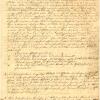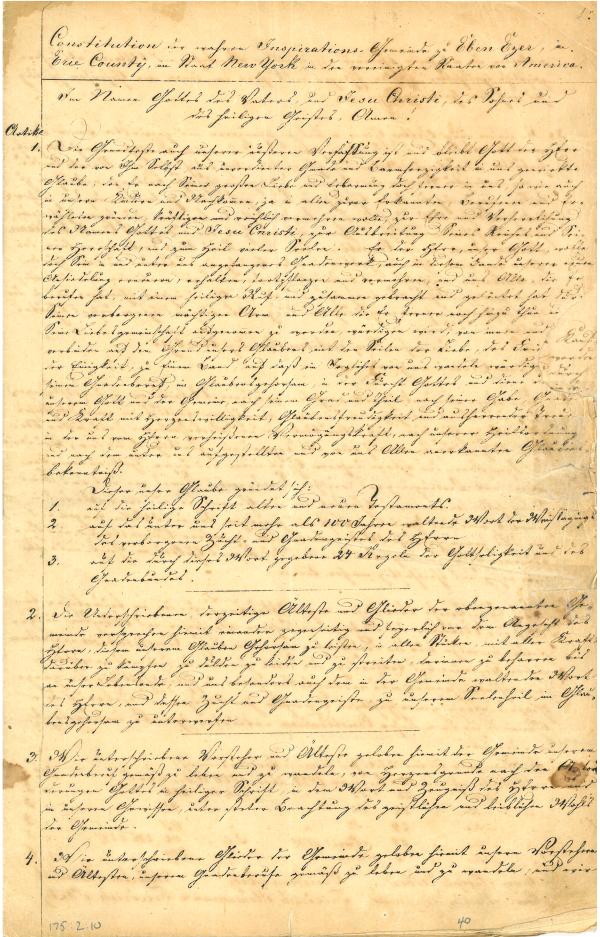Do you know your rights?
| Grade | 5th Grade | Class | Social Studies | Length of Lesson | 40-45 Minutes |
| Lesson Title | Do you know your rights? |
| Unit Title | Rights and Responsibilities: Founding Documents |
| Unit Compelling Question | Why aren't all rules good rules? |
| Historical Context: September 25, 1789 Congress went to the state legislatures to propose twelve amendments to the Constitution. Amendments three through twelve were adopted by the states to become the United States Bill of Rights. The United States Bill of Rights plays a big role in law and government as it is a fundamental symbol of freedom and the culture of our nation. The Bill of Rights is a basic understanding of our natural rights and freedoms as citizens of the United States of America. The ten amendments in the Bill of Rights guarantee the freedoms or privileges of American citizens. ~Allyson Simpson, Simpson College 2018.040.012 The Community of True Inspiration drafted this constitution for their Ebenezer Colonies, which they founded in New York. The constitution outlined the society's structure and the rights and responsibilities of the society's leaders and members. When the Community of True Inspiration moved to Iowa, they continued to use many of the features of this constitution. The Community of True Inspiration came to the United States in the 1840s and founded a community known as the Ebenezer Colonies in New York. In the 1850s, the group created a new set of communal villages in Iowa known as the Amana Colonies. The settlers of the Amana Colonies maintained an independent and religious lifestyle until 1932. The community then split into two organizations: the non-profit Amana Church Society and the for-profit Amana Society. Photographs of the original German constitution and an English translation are attached. The Community of True Inspiration was a religious organization founded in 1714 under Eberhard Ludwig Gruber and Johann Friedrich Rock near Himbach, Germany. The group followed the religious formations of Pietism which focused on Bible study, prayer and meeting the spiritual needs of the people by connecting to God. The group was met with controversy as the members did not take part in military duties and sent their children to church-led schools. To escape prejudice, group moved short-term to Buffalo, New York before settling in Iowa. The village was named "Amana", meaning "remain true" from Song of Solomon 4:8. The first Amana Colony in Iowa was founded in 1854 by 800 immigrants from Germany who formed the Society of True Inspirations. Described as a utopian-style organization, the group created a communal society that supported the religious and specific lifestyle that had been persecuted against in Germany. After arriving in Iowa, the colonies expanded to 7 villages spread over 26,000 acres and the residents created an economic living by establishing small businesses such as shops, bakeries, wineries, and through small factories creating furniture and other household items. The society also found work in farming. All residents were guaranteed food, shelter, money and health care in the communal setting, along with being provided a stable retirement plan. Families lived in apartments that were assigned to each family by the elders of the community depending on how new the family was and the size of the family. All buildings in the community were organized in a central pattern to create close connections with each other and in agreement that all property was shared. The religious beliefs of the Amana residents focused on giving care and primary focus to the elderly. Housing was made to benefit the elderly by allowing them to live closer to their families and by creating an economic system that provides long term care for the elderly. |
|
| Lesson Supporting Question | |
| Lesson Overview | In this lesson, students begin by learning about the specific rules and freedoms protected by the Bill of Rights. They will also learn about the amendments in the Bill of Rights. The students will then be able to use the knowledge they have learned to construct a classroom Bill of Rights, or rules. |
| Primary Sources Used |
|
| Resources Needed | |
| Standard | |
| Lesson Target | The students will create a set of at least 5 students responsibilities within the classroom. ;The students will create a set of at least 5 teacher responsibilities within the classroom. ;The students will identify the importance of having rights and responsibilities. |
| Lesson Themes | Lawmaking |
|
| Formative Assessment (How will you use the formative assessments to monitor and inform instruction?) |
|
| Summative Assessment (How does the lesson connect to planned summative assessment(s)?) |
| Author | Tonya Greve | Created | Last Edited | ||||
| Reviewer: Dr. Chad Timm, Simpson College | |||||||
| Lesson Plan Development Notes: Social Studies Methods, Simpson College, Spring 2019 | |||||||


